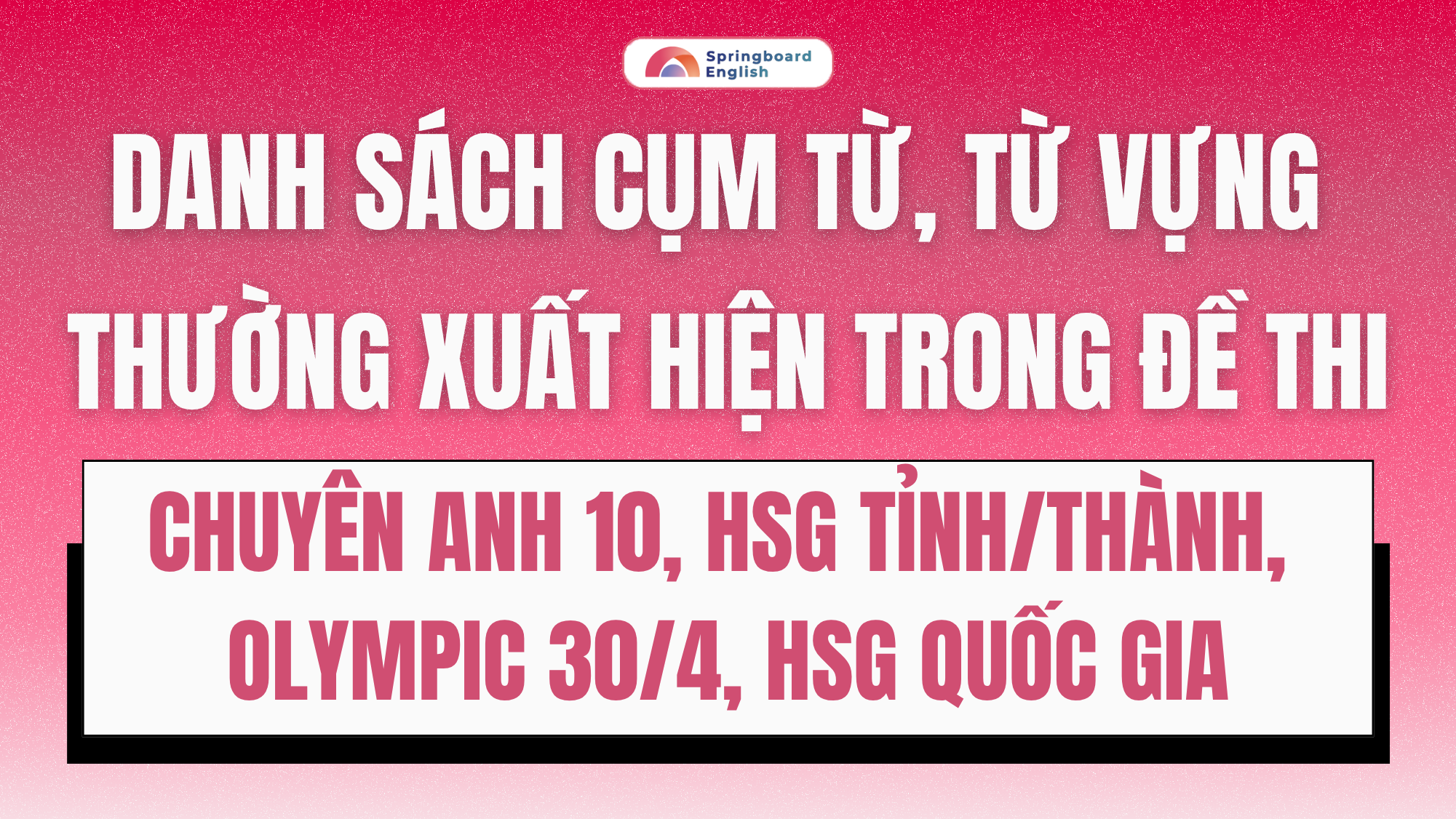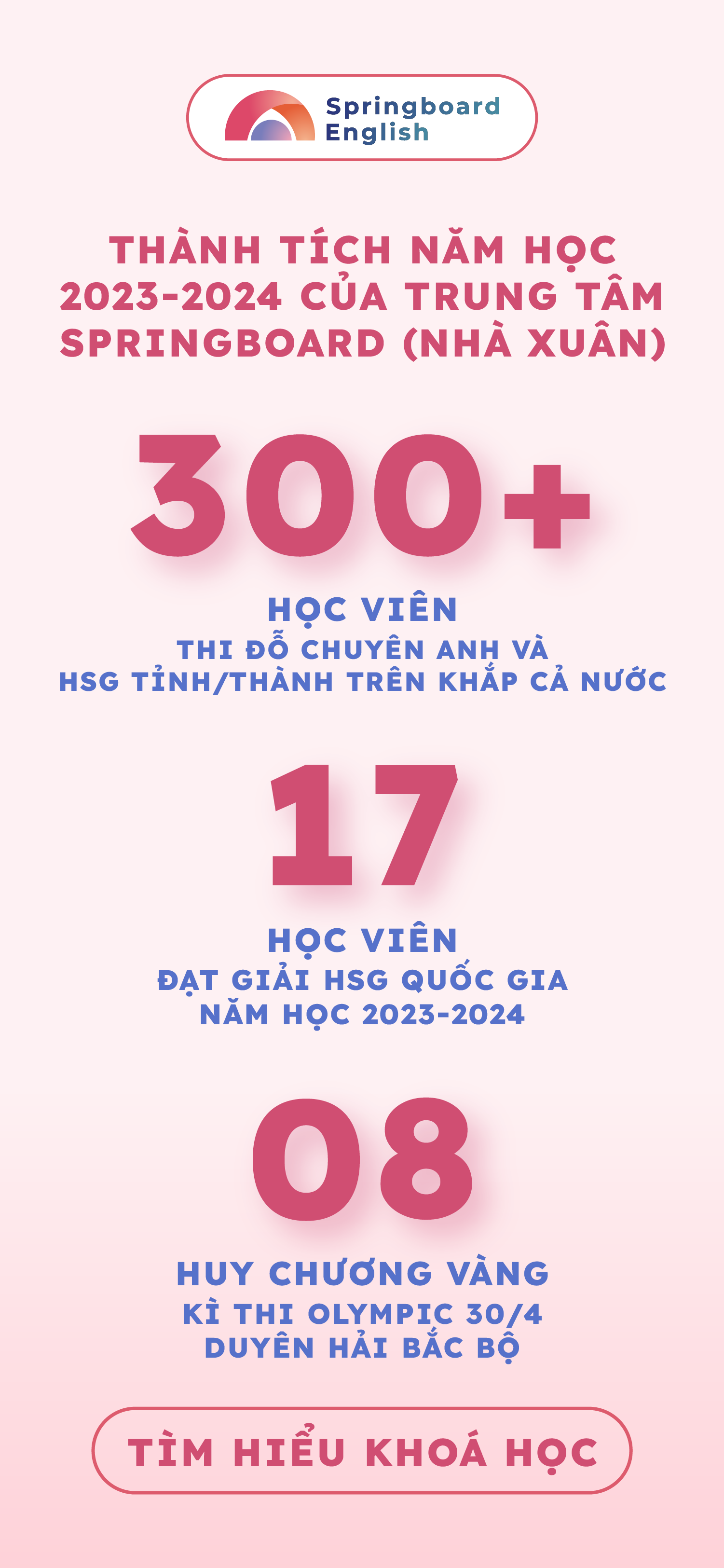Đề thi và Đáp án Chi tiết Kì thi Chuyên Anh 10, Chuyên Anh tỉnh Tây Ninh năm 2025-2026
Đội ngũ anh chị trung tâm Springboard (Nhà Xuân) xin gửi đến các quý phụ huynh, thầy cô, các em học sinh tổng hợp đề thi và đáp án đề thi Chuyên Anh vào lớp 10 tỉnh TÂY NINH, thi vào THPT Chuyên Hoàng Lê Kha năm 2025-2026 (có đáp án và giải thích chi tiết).
Phần đáp án chi tiết được giới thiệu ở bài viết này là tài liệu được biên soạn trực tiếp bởi đội ngũ chuyên môn Nhà Xuân, đồng thời là bản cập nhật mới nhất trong năm 2025.
Kéo xuống dưới cùng để xem hết đáp án có giải thích chi tiết.
Đề thi Chuyên Anh vào 10, Chuyên Anh tỉnh Tây Ninh năm 2025-2026
| SỞ GIÁO DỤC VÀ ĐÀO TẠO TÂY NINH ĐỀ THI CHÍNH THỨC (Đề thi gồm có 08 trang) |
KỲ THI TUYỂN SINH VÀO LỚP 10 THPT NĂM HỌC 2025 – 2026 Môn thi: TIẾNG ANH (chuyên) Thời gian làm bài: 150 phút, không kể thời gian phát đề Ngày thi: 05 tháng 6 năm 2025 |
I. LISTENING: (2/10 MS)
Part 1 (0.5 M)
You will hear part of a radio program called Backtrack Beats, in which the host, Riley Parker, describes a typical day for a teenager in 1980. For questions 1–5, choose the answer (A, B, or C) which best fits according to what you hear. Write your answers on your answer sheet.
- What does Riley say about preparing a cassette tape in 1980?
| A. It involves selecting songs with care. |
| B. It requires purchasing new tapes regularly. |
| C. It depends on access to live music. |
- How does Riley describe the arcade’s role for teenagers?
| A. It serves as a place for relaxation. |
| B. It fosters excitement and competition. |
| C. It promotes learning new skills. |
- What does Riley find rewarding about researching in 1980?
| A. Collaborating with classmates |
| B. Discovering the right information |
| C. Using efficient library systems |
- How many shots are available per pack of Polaroid film, according to Riley?
| A. Eight shots |
| B. Twelve shots |
| C. Ten shots |
- What does Riley highlight as a key benefit of life in 1980?
| A. Freedom from external influences |
| B. Access to instant global news |
| C. Ease of capturing daily moments |
Part 2 (1 M)
You will hear a radio report about healthy lifestyles for teens. For questions 6–15, complete the sentences with NO MORE THAN TWO WORDS. Write your answers on your answer sheet.
- Leo used to spend most of his free time in his _____.
- Leo says physical activity helps him excel in school and plan his _____.
- Now, he aspires to be a _____, perhaps working on skate videos or film trailers.
- Leo finds that doodling boosts his _____ and reduces stress.
- Leo describes skating and doodling as his _____ for success.
- Leo advises teens to start with simple tools like a skateboard and a _____ to pursue their passions.
- Leo is creating a short skate video that combines his tricks with _____ doodles for his blog.
- Leo is trying to start a _____ at his school to help other kids embrace skating.
- Leo encourages teens to pursue activities that make their _____ to fuel their dreams.
- The host inspires teens to pursue their passions actively, envisioning themselves as the _____ of their own epic tale.
Part 3 (0.5 M)
You will hear a conversation about a handmade chocolate business. For questions 16–20, decide whether the following statements are True (T) or False (F). Write your answers on your answer sheet.
- The bank helped Eva and John by highlighting what should be taken into consideration.
- Other small business owners recommended redesigning the shop.
- With regard to their website, Eva and John thought it was essential to ensure clients could easily get in touch.
- Their chocolates are not made by hand anymore to maintain its original taste.
- Eva and John find it useful to speak to other bank customers because they realise how much they now know.
II. LEXICO-GRAMMAR: (2.5/10 MS)
Part 1 (1 M)
For questions 21–30, choose the word or phrase that best completes each sentence. Write your answer (A, B, C or D) on your answer sheet.
- When John decided to start his own business, he knew he was taking a big risk, but he was determined to _____ and give it his all.
| A. play it safe |
| B. swing for the fences |
| C. cut corners |
| D. sit on the fence |
- He always sticks to the basics and never tries anything new; he should really get someone to _____ at the next party.
| A. calm things down |
| B. jazz it up |
| C. sit it out |
| D. bring it down |
- What started as a small misunderstanding quickly _____ a major issue that affected the entire team.
| A. snowballed into |
| B. snowballed over |
| C. snowballed out |
| D. snowballed off |
- The new coach didn’t think _____ of players who skipped training sessions; he promptly benched them for the next game.
| A. sharply |
| B. poorly |
| C. highly |
| D. immensely |
- He thought he was the best player on the team, but losing the match _____ him down to size.
| A. made |
| B. reduced |
| C. chopped |
| D. cut |
- _____, she consented to assist her friend with the project.
| A. Exhausted as was she |
| B. Exhausted so she was |
| C. Was exhausted as she |
| D. Exhausted as she was |
- Not until the lecture had concluded _____ to pack their belongings.
| A. had the students begun |
| B. did the students begin |
| C. the students began |
| D. were the students |
- It is imperative that the chairman formally _____ the proposal prior to the deadline to ensure the project’s timely advancement.
| A. approve |
| B. approves |
| C. will approve |
| D. approved |
- She had been working for hours, and when she finally took a break, she realized she had done _____ work for the day.
| A. much too much |
| B. too much and much |
| C. too much too |
| D. much enough |
- She was tired after the long day, but she _____ finish the project tonight than leave it incomplete.
| A. would just as soon |
| B. would prefer to |
| C. should as soon |
| D. ought to |
Part 2 (0.5 M)
The passage below contains 5 mistakes. UNDERLINE the mistakes from 31 to 35 and WRITE their correct forms on your answer sheet. (0) has been done as an example.
Example (0): Japan are ➝ is
Japan are home to breathtaking natural wonders that captivate teenagers with their beauty and adventure. Mount Fuji, an iconic symbol of Japan, stands as a majestic volcano with its snowy peak, offers hiking trails that challenge and inspire young explorers. Its serene presence is perfect for photography and appeals to teens who love capturing nature’s grandeur. The Arashiyama Bamboo Grove in Kyoto, with its towering green stalks swaying gentle, creates a tranquil, almost magical atmosphere, ideal for those seeking peace or a unique Instagram backdrop. Yakushima Island, a UNESCO World Heritage Site, enchants with its ancient cedar forests and moss-covering trails. The vibrant blue waters of Miyako Island’s beaches beckon snorkelers and swimmers, enchanting adventure-seekers with coral reefs brimming with marine life, though the challenges of navigating ocean currents. These natural wonders, harmonizing thrill and tranquility, establish Japan as an essential destination for young nature lovers, cultivating a profound respect for the earth’s splendor, regardless of cultural or religious differences. Even the bustling excitement of Osaka’s street markets and the historic charm of Nara’s ancient temples pale on comparison to the awe-inspiring beauty of Japan’s natural wonders.
Part 3 (1 M)
Read the text below. For questions 36–45, use the word given in capitals in brackets to form a word that fits in the gap. Write your answers on your answer sheet.
City life is a thrilling blend of the old and the new, where the (36. NECESSARY) _____ of modernity meets the allure of endless opportunities. In the heart of a bustling metropolis, we will find that the (37. DESCEND) _____ of past generations have built a legacy of innovation and ambition. For many, moving to the city is not merely a choice but a (38. PERSUADE) _____ call to enhance their lives, providing access to cutting-edge technology, diverse cultures, and exciting career prospects. Yet, amid the glimmer of progress, some aspects of urban life have become (39. MODE) _____, like old-fashioned public transport systems or outdated infrastructures that struggle to keep pace with (40. GROW) _____.
The future of city living hinges on how we adapt and upgrade. Cities must evolve (41. RELY) _____, adopting new solutions to ensure (42. SUSTAIN) _____ without losing the essence of what makes them great. What makes city life truly intriguing is the constant push toward reinvention, where every corner (43. SIGN) _____ the potential for change, improvement, and progress. As we move toward smarter cities, the question remains: can we balance development with the (44. PRESERVE) _____ of the unique characteristics that make urban life so exhilarating? The answers lie in how we embrace the future while staying (45. GROUND) _____ in the lessons of the past.
III. READING: (3/10 MS)
Part 1 (0.6 M)
Read the following passage and for questions 46–51, choose the answer (A, B, C or D) which you think fits best according to the article. Write your answers on your answer sheet.
The Rise of Bubble Tea: A Sip Through History
Picture this: it’s a scorching afternoon in Ho Chi Minh City, and you’re craving something cool, sweet, and just a little bit quirky. Here comes bubble tea, the drink that’s taken Vietnamese teens by storm and turned every street corner into a tapioca pearl paradise. But where did this chewy, slurpy sensation come from? Buckle up for a wild ride through the history of bubble tea, a tale of creativity, rebellion, and some seriously stretchy straws.
Back in the 1980s, Taiwan was buzzing with night markets and snack stalls, but nobody had quite cracked the code for a drink that screamed “fun.” That is, until a tea shop owner in Taichung, Liu Han-Chieh, decided to shake things up, literally. Inspired by Japanese cold coffee shaken with ice, Liu started shaking his tea to make it frothy and refreshing. Teens loved it, but Liu wasn’t done. One day, his employee, Lin Hsiu Hui, got a bit cheeky during a meeting and dumped her tapioca pudding into her iced tea. The result? A drink with chewy pearls that bobbed like tiny moons in a milky galaxy. Bubble tea was born, and Taiwan’s youth went nuts for it.
By the late 1980s, bubble tea stalls were popping up faster than K-pop fan clubs. The drink’s secret weapon? Customization. Want green tea or black tea? Milk or no milk? Big pearls or mini ones? The choices were endless, and teens loved playing mad scientist with their orders. Shops started adding funky flavors like taro, lychee, and passionfruit, turning every sip into a mini adventure. To keep things affordable, vendors used local ingredients, which made bubble tea a hit with students who didn’t have much cash but still wanted to flex their style.
The 1990s saw bubble tea leap from Taiwan to the world stage. Taiwanese immigrants brought the drink to places like California, where it became a staple in Asian-American communities. But it wasn’t all smooth sipping. In certain countries, the unusual chewy texture elicited skepticism, while health-conscious individuals expressed concerns regarding the beverage’s sugar content. In response, shops got creative, providing low-sugar options and even swapping pearls for aloe vera or fruit jelly. This adaptability kept bubble tea in the game, and by the 2000s, it was a global phenomenon, with cafes in London, Sydney, and even Hanoi.
Vietnam, with its love for sweet drinks and vibrant cafe culture, was a match made in heaven for bubble tea. When the first shops opened in Hanoi and Ho Chi Minh City around 2010, teens flocked to them like moths to a neon sign. Brands like Gong Cha and The Alley turned bubble tea into a lifestyle, with Instagram-worthy cups and queues longer than a Tet holiday traffic jam. To stand out, Vietnamese shops added local twists, like using fresh coconut milk or pandan flavor, which gave the drink a desi vibe that kids couldn’t resist.
But bubble tea’s journey wasn’t without hiccups. In 2015, a rumor spread online that tapioca pearls were made from plastic, sending panic through group chats. Bubble tea brands fought back with transparency, showing off their all-natural ingredients and even hosting “pearl-making” workshops. The scare passed, and if anything, it made teens love their bubble tea even more for surviving the drama.
Bubble tea’s also got a heart. Many shops in Vietnam support local farmers by sourcing tea leaves from places like Da Lat and fruit from the Mekong Delta. Some even donate part of their profits to community projects, like building libraries for rural kids. Plus, the drink has inspired a wave of creativity, with teens designing their own bubble tea art, from stickers to phone cases.
Today, bubble tea is more than a drink; it’s a vibe. Whether you’re slurping a matcha boba with friends or snapping a pic of your rainbow-layered drink, it’s a symbol of youth, freedom, and a little bit of mischief. As health trends grow, shops are rolling out options like kombucha-based bubble tea or drinks with chia seeds, proving this sippy superstar isn’t going anywhere.
- Which of the following best explains the meaning of “went nuts for it” in paragraph 2?
| A. They reacted with overwhelming excitement. |
| B. They became skeptical about its appeal. |
| C. They showed no strong feelings toward it. |
| D. They grew increasingly critical of it. |
- How did bubble tea shops in the 1980s appeal to teenagers?
| A. By providing free drinks to students on weekends for enjoyment |
| B. By organizing live music events at stalls for entertainment |
| C. By sourcing expensive imported ingredients to enhance drink quality |
| D. By giving customers the freedom to tailor their drinks extensively |
- What challenge did bubble tea face when it first went global?
| A. A lack of interest from younger consumers |
| B. High costs of setting up international shops |
| C. Doubt regarding its unconventional components |
| D. Strict regulations on sugary drinks |
- How did bubble tea shops in Vietnam distinguish their beverages?
| A. By focusing only on classic Taiwanese recipes |
| B. By lowering prices below competitors |
| C. By reducing the variety of drink options |
| D. By incorporating local flavors and ingredients |
- What was the outcome of the 2015 rumor about tapioca pearls?
| A. Bubble tea shops closed down temporarily. |
| B. Teens became more loyal to the drink. |
| C. Brands stopped using tapioca pearls entirely. |
| D. The government banned bubble tea sales. |
- How has bubble tea adapted to modern health trends?
| A. By introducing drinks with alternative bases like kombucha |
| B. By eliminating sweet flavors from their drink menus |
| C. By concentrating solely on low-calorie milk tea options |
| D. By enlarging the size of their beverage offerings |
Part 2 (0.9 M)
You are going to read an extract from an article in which five individuals share their experiences with family traditions. For questions 52–60, choose from the sections (A–E). The sections may be chosen more than once. Write your answers on your answer sheet.
In which section are the following mentioned?
- A healthy habit that initially felt like a burden but later became enjoyable
- A shared activity that turned messy but strengthened family bonds
- A skill that ended up impressing the writer’s peers
- A routine that provides a calm start to hectic days
- An early adoption of a lifestyle that became trendy later
- A moment of appreciating creativity in healthy cooking
- An instance where being healthy was unexpectedly funny
- An ancestor’s or relative’s serious enthusiasm for sports
- A discovery that a small habit can have a big impact
Healthy Habits: A Family Affair
Five teens reveal how healthy living naturally became part of their families’ identities.
A. The weekend warriors
In my family, weekends have always meant one thing: sweating buckets. Every Saturday at dawn, my parents rally the troops for what they insist is a “light” hike, which somehow spirals into an epic five-hour expedition involving questionable shortcuts and motivational speeches. As a small child, I genuinely believed this was some form of punishment. A few years later, I came to understand that those trails not only strengthened my muscles but also developed my resilience. Now, whenever I smell pine trees or see a winding dirt path, a weird sense of excitement bubbles up. Nature has an uncanny ability to clear our head, no matter how many blisters it leaves behind. Looking back, I am genuinely grateful for every early morning groan and every victory sandwich eaten at a windy summit.
B. The smoothie squad
Imagine a kitchen where the blender is louder than the television, and you have a snapshot of my childhood. My mum, the undisputed queen of kitchen chaos, dedicated herself to creating the ultimate healthy smoothie. From kale and spinach to some very questionable experiments involving pickled beets, everything was fair game! We were knee-deep in chia seeds before they became Instagram-famous. Some mornings, the concoctions were so revolting, we had to do rock-paper-scissors to decide who took the first sip. But as strange as it sounds, those culinary disasters brought us together. They taught me that healthy living does not have to be grim or restrictive; it can be downright hilarious. And honestly, if you can survive a spinach-broccoli-banana smoothie, you can survive anything.
C. The mindful mornings
While most families turn mornings into a full-blown sprint, ours moves at the pace of a sleepy snail. Thanks to my dad’s unwavering dedication to mindfulness, breakfast is a tranquil ritual. Every morning, before even thinking about cereal, we sit quietly for five minutes, focusing on breathing and letting go of whatever nonsense the day is about to throw at us. As a hyperactive tween, I once thought it was barking mad, but now, truth be told, I rely on it. Even on days when deadlines pile up like Jenga towers or group chats spiral into chaos, that little pocket of calm makes a world of difference. I have come to see that a small habit, if done consistently, has a profound impact on how we tackle life’s curveballs.
D. The plant-based pioneers
While my friends’ houses smelled of burgers and fries, ours always smelled suspiciously like roasted cauliflower. Our Sundays were a grand production of experimenting with tofu marinades, quinoa salads, and vegetable stir-fries of every imaginable hue. Although I sometimes yearned for a greasy cheeseburger, I grew to appreciate the inventiveness involved in making plants exciting. My parents were true pioneers, embracing plant-based eating long before it became a fashionable hashtag. Now, I can crave a chickpea curry with the same enthusiasm some people reserve for chocolate cake. Watching their creativity in the kitchen made me realize that living well does not mean sacrificing joy; it simply means learning to celebrate it differently.
E. The fitness fanatics
Inheritance usually means jewelry or old furniture. In my case, I inherited a passion for squats and burpees. Every family holiday included yoga mats tucked into suitcases and colour-coordinated running outfits that made us look like a synchronized flash mob. Even at Christmas, while other families were slumped in front of the TV, we were doing “festive plank challenges” by the fireplace, much to the horror of visiting relatives. At the time, I thought it was over the top, and I often dreamed of escaping into a normal life where a treadmill was not considered a valid birthday present. But looking back, I realise that this relentless dedication to fitness gave me something far more valuable than six-pack abs. As time passed, I began to see my friends admire my dedication and ask for tips on how to improve their own fitness routines, proving that my commitment to health had started to resonate with them. It taught me discipline, perseverance, and the satisfactory feeling of pushing past my limits.
| Question | Content Description | Answer (Section) |
|---|---|---|
| 52 | A healthy habit that initially felt like a burden but later became enjoyable | |
| 53 | A shared activity that turned messy but strengthened family bonds | |
| 54 | A skill that ended up impressing the writer’s peers | |
| 55 | A routine that provides a calm start to hectic days | |
| 56 | An early adoption of a lifestyle that became trendy later | |
| 57 | A moment of appreciating creativity in healthy cooking | |
| 58 | An instance where being healthy was unexpectedly funny | |
| 59 | An ancestor’s or relative’s serious enthusiasm for sports | |
| 60 | A discovery that a small habit can have a big impact |
Part 3 (0.5 M)
Read the following passage and for questions 61–65, decide which answer (A, B, C or D) best fits each gap. Write your answers on your answer sheet.
The Ultimate Teen Music Mash-Up
Teens and music go together like peanut butter and jelly, but my friends and I take it to a whole new level. Last weekend, we decided to host a “Genre Mash-Up Party” to settle a debate about the best music for our generation. It was a chaotic but laugh-out-loud success. We (61) _____ things off with my playlist of indie pop, which I thought would (62) _____ everyone’s love for chill vibes. But my bestie, Mia, had other ideas. She blasted her K-pop tracks, dancing with such zeal that we were all left gobsmacked. Her energy was so infectious that even the grumpiest among us couldn’t help but join in. Then, Jake, our resident rapper, decided to (63) _____ the mood with his booming hip-hop beats. The bass was so intense that my little brother thought the house might implode. My parents, trying to be cool, attempted a dance move that was utterly deplorable, leaving us in (64) _____. Amid the chaos, I elucidate how music unites us despite our differences. Mia suggested we create a collaborative playlist, which ignites our creativity like never before. By the end, our party didn’t just settle the debate, it (65) _____ how music can bridge any gap, making our teen squad stronger than ever.
| 61. | A. kicked B. shot C. threw D. tore |
| 62. | A. quell B. stifle C. thwart D. kindle |
| 63. | A. alleviate B. exacerbate C. ponder D. fathom |
| 64. | A. stitches B. sticks C. lines D. circles |
| 65. | A. undermined B. overshadowed C. illuminated D. lamented |
Part 4 (1 M)
Read the text below and for questions 66–75, think of the word which best fits each gap. Use only ONE word in each gap. Write your answers on your answer sheet.
Habits are the secret sauces that make or (66) _____ our planet’s future. As teens, we can turn small daily choices into big environmental wins by swapping wasteful routines for sustainable ones. Ready to go green? Let’s make saving the Earth our new flex. Our habits are the backbone of our everyday (67) _____. They’re like the Wi-Fi signal keeping our lives connected, so let’s make them eco-strong. Kicking bad habits to the (68) _____ isn’t easy; it requires serious effort to ditch single-use plastics or cut down on food waste. Experts reckon it (69) _____ around 21 days to cement a new habit, so don’t bail if it feels tough at first. Stick with it, and you’ll be a green machine in (70) _____ time. Taking that first step can feel like diving into the deep end, (71) _____ it’s worth it. Once you start recycling or thrifting, those small changes add up fast. Stepping outside your comfort zone to try new eco-habits sparks serious growth. For example, (72) _____ up a reusable water bottle or joining a local cleanup crew can make you a planet-saving rockstar. At school or home, green habits can open new doors. Getting (73) _____ the habit of composting or biking to class can shrink your carbon footprint and boost your cred. When you go the extra mile with eco-projects, you’re (74) _____ just helping the planet; you’re setting the stage for a brighter future. By turning challenges into opportunities, teens (75) _____ lead the charge and make the Earth a happier, healthier place.
IV. WRITING: (2.5/10 MS)
Part 1 (0.5 M)
For questions 76–80, complete the second sentence so that it has a similar meaning to the first sentence, using the word given. Do not change the word given. Write your answers on your answer sheet.
- Lisa is a much more talented singer than Karen.
→ Karen is nowhere ……………………………………………………………………………………… - The firefighter acted quickly so the building didn’t collapse with people inside.
→ Had it …………………………………………………………………………………………………………… - Emma trained tirelessly for the marathon, but she still couldn’t achieve her goal time.
→ However ……………………………………………………………………………………………………… - The two team leaders were in constant conflict over the project’s direction, unable to agree on even the smallest details. (LOGGERHEADS)
→ The two team leaders ……………………………………………………………………………………… - Although life gets busy, it’s important to pause and enjoy the simple pleasures once in a while. (ROSES)
→ Although life gets busy, it’s important to ………………………………………… once in a while.
Part 2 (2 MS)
The increasing use of AI tools by teenagers for academic tasks, without fostering independent thinking and problem-solving skills, poses a challenge to education.
Do you agree or disagree with this? Write an essay of about 250 words to express your opinion and support your answer with relevant examples from your own knowledge or experience.
Cảm ơn quý phụ huynh, thầy cô, và các em học sinh đã tham khảo tài liệu được biên soạn bởi Nhà Xuân.
Với nỗ lực để luôn tạo ra những bài giảng – học liệu hay nhất dành cho kì thi chuyên Anh – HSG tiếng Anh cấp tỉnh/thành phố đến cấp Quốc Gia, đội ngũ mentors trung tâm Springboard (Nhà Xuân) luôn biên soạn những tài liệu mới nhất với giải thích tận tâm – chi tiết.
Quý phụ huynh/ quý thầy cô/các em học sinh có thể truy cập các kênh sau để cập nhật tài liệu mới nhất từ Nhà Xuân:
- Facebook page Springboard English: Trang Facebook chính thức của Nhà Xuân
- Facebook group Springboard Connects: Nhóm trao đổi – tư vấn học tập, và tài liệu học tập với 30.000+ thành viên
- Website học liệu – springboard.vn :Trang web tổng hợp tất tần tật các tài liệu được biên soạn chi tiết bởi Springboard (Nhà Xuân).
Liên hệ:
- Gửi đề thi mới nhất cho Nhà Xuân về địa chỉ: contact@springboard.vn
- Tham khảo và đăng ký tư vấn các lớp học ôn thi Chuyên Anh – Thi HSG Tiếng Anh cấp THPT – Thi Olympic 30/4 và Duyên Hải Bắc Bộ – Thi HSG cấp Quốc Gia tại: Form đăng ký tư vấn.
Thân ái,
Đội ngũ trung tâm Springboard (Nhà Xuân)






















